THE TRINITY VOICE SOCCER STATE CHAMPS

March 2O23
Volume 25 Issue 5
Trinity Preparatory School


57OO Trinity Prep Lane Winter Park, FL 32792
Page 27
NEWS OPINIONS FOCUS
Annual Sadie Hawkins dance has long historical controversy
LIFESTYLES
SPORTS

Anti-aging science and culture has gone too far, hurting consumers
Page 2O-21
From game shows to music, explore the ways pop culture changes through generations
The taste and value of five local boba shops, ranked and reviewed Page 5
Page 1O
Page 8-9
Sophomore pitcher Aiden Stillman captures college attention
Page 25
e Trinity Voice is a member of the Florida Scholastic Press Association and the National Scholastic Press Association.
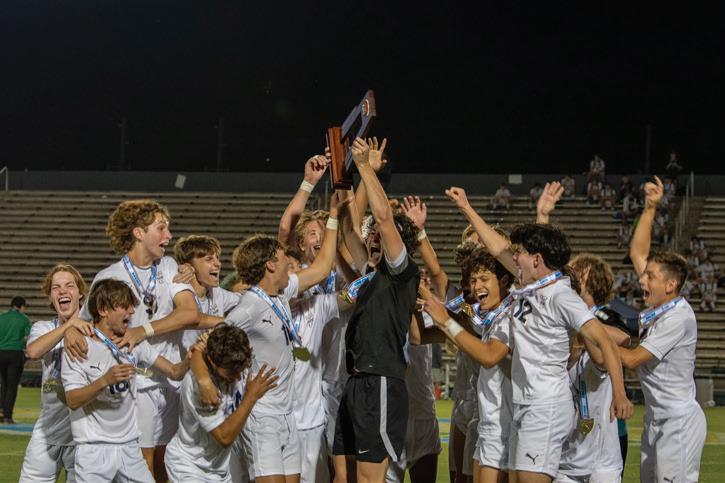



























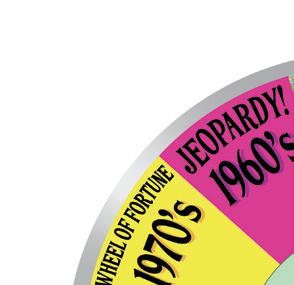










e Trinity Voice is produced by the newspaper/journalism class at Trinity Preparatory School of Florida. Editorials represent the opinion of e Trinity Voice writer and are not necessarily the views of the administration, faculty, or Board of Trustees of Trinity. e Voice welcomes letters to the editor and freelance articles or photography. All submissions become the property of e Voice. Please send all correspondence to 5700 Trinity Prep Lane, FL 32792. e Voice may also be contacted via phone at 407-671-4140 and via e-mail at voice@trinityprep.org. For information regarding the purchase of advertising within e Voice, contact us by one of the methods mentioned above. The Voice is a monthly publication during the school year (with the exceptions of November and January).

CONTENTS March 2O23 Table of Contents
TABLE OF
VOICE@TRINITYPREP.ORG THETRINITYVOICE.COM @TRINITY_VOICE @THETRINITYVOICE “THE TRINITY VOICE” Opinions Anti-Aging 22 2O-21 Nathaneal Davis Sports 24 Aiden Stillman 25 News News Spotlight O4 O5 Sadies Dance Lifestyles Boba Rankings O8-O9 O7 Marvel Barbie O6 Con: Advanced Classes 23 Page 18 Andrew Edwards Focus Childhood 11 Games 12-13 Celebrites 14-15 Progressiveness 16 Music 17 Game Shows 18 Ben Demetriades 26 Boys Soccer 27
6
Page
Olivia Kortman
Cover Photo
Pro: Advanced Classes
Andrew Edwards
STAFF
Editors-in-Chief: Marcos Membreno, Jack Ververis
Managing Editors: Sarah Zehnder, Ava Savino
Copy Editor: Kaylee Ortega
Layout Editors: Amy-Ruth Gyang, Reese Taylor
Social Media Editors: David Bryskin, Ana Carolina Marques
News Department: Iris Lei (Editor), Julian Sealy, Alec Diaz, Karthik Stead, Laziza Talipova

Opinions Department: Abby Hernan (Editor), Reese Taylor, Amanda Rose DeStefano
Focus Department: Peyton Alch
(Editor), Fay Zhao, Lucy Chong, Zach Kleiman
Lifestyles Department: Taylor Riley
(Editor), Jack Aaron, Kaylee Ortega, Boaz Kim, Sammy Lou

Sports Department: David Steinberg
(Editor), David Hull
Podcast Department: Aetant Prakash (Editor), Mohil Kapadia, Sreekar Nagulapalli
Graphics Department: Amy-Ruth Gyang (Editor), Austin Yuan, Andrew Edwards, Caden Liu, Lia Garibay
Photo Department: Anna Miliotes (Editor), Andrew Edwards, Raheel Patel, Olivia Kortman, Olivia Prince
Fact Checking Editors: Boaz Kim, Julian Sealy
Business Manager: Sreekar Nagulapalli



Adviser: Erin Miller
Saint Talk

This Month’s Podcast: Ep.9 - Chess Checkmates Trinity
Since the new year, Trinity students have been infected with a new craze: chess. From physical boards in the library to online games on sites like Chess.com, students are passing their time in a new way on campus. To explore the trend, Mohil Kapadia talks with junior Sam Rinaldi and Dr. Kenneth Regan, an international chess master.

March 2O23 Sta /Podcast
Blurb by Mohil Kapadia
Photo by Olivia Kortman
Wind


-1O8°F
This Month: By the Numbers 32

Beyoncé
23
Tom

The Headlines
Quote of the Month
This College Board—nobody elected them to anything. They’re just kind of there and provide this service, and you can utilize those services or not.
Sports Spotlight








 Florida Governor Ron Desantis on College Board and the possible banning of AP Classes in the state of Florida.
breaks all time Grammy win record
chills in New Hampshire reach lowest recorded temperature
Brady retires after 23 seasons in the NFL
Chinese spy balloon and other mystery objects shot down by U.S. military
Multiple high magnitude earthquakes leave thousands dead and others injured in Syria and Turkey
Kansas City Chiefs win their second Super Bowl in four years with Patrick Mahomes taking home his second SB MVP
Boston Celtics’ Jayson Tatum wins the NBA All Star Game MVP with a record breaking 55 points
Florida Governor Ron Desantis on College Board and the possible banning of AP Classes in the state of Florida.
breaks all time Grammy win record
chills in New Hampshire reach lowest recorded temperature
Brady retires after 23 seasons in the NFL
Chinese spy balloon and other mystery objects shot down by U.S. military
Multiple high magnitude earthquakes leave thousands dead and others injured in Syria and Turkey
Kansas City Chiefs win their second Super Bowl in four years with Patrick Mahomes taking home his second SB MVP
Boston Celtics’ Jayson Tatum wins the NBA All Star Game MVP with a record breaking 55 points
News 4 March 2O23
Former U.S. President Jimmy Carter enters home hospice care at the age of 98
STORY OF SADIES
A controversial comic strip inspires the Sadie Hawkins tradition
Article by Laziza Talipova
Photo by Anna Miliotes
Popular school dances such as prom and homecoming always create a lot of buzz–girls excitedly shop for dresses, friend groups coordinate dinner plans, etc. But historically this level of excitement hasn’t surrounded the February Sadie Hawkins dance. In fact, this sophomore led dance has become a struggle this year. Just over 100 students attended this dance compared to homecoming, which had around 480 students.
Student council adviser Bozena Lawson gets to oversee the creation process of the dance.
“So the idea of the Sadie Hawkins dance is, the ninth and tenth graders get to be in charge of the dance…and I know our school Trinity, the dance is a tradition for over 40 years,” Lawson said.




e name “Sadie Hawkins” came from a controversial comic strip. In the comic strip, Li’l Abner, the main protagonist of the story is a girl named Sadie with unattractive features who fails to catch a husband even with the help of her own father, the town’s most wealthy and powerful man, Hezekiah. Hezekiah feared his daughter would live without a husband at age 35 and suffer humiliation of becoming an old maid. To avoid this, he declared Sadie Hawkins Day a mandatory event and called all of the bachelors in town. e event consisted of a race of the eligible bachelors with Sadie chasing after them. Whoever Sadie caught was legally bound to marry her. is inspired real-world Sadie Hawkins events, the premise of which is that women ask men out on a date or to a dance.
Whether people call it a Sadie Hawkins dance, Turnabout, or something different, Sadie’s is a long-lasting tradition in most high schools nationwide. Unlike most dances when boys ask girls, Sadie Hawkins provides an opportunity to switch these conventional gender roles so girls can ask guys out. Lawson believes the gender role switch doesn’t matter as long as the students have fun.
Hawkins when she was a student at Trinity.
“ e guys would ask the girls to homecoming and prom,” Wehr said. “So that was just the switch around…it was always exciting and also nerve-wracking to witness.”
Student council picks the theme for these types of dances every year and it’s a whole process to decide.
“Student councils meets in the summer and they start conversation about all their activities and events, which happens during the year,” Lawson said. “One of the conversations we have, it’s about the Sadie Hawkins event. So we select the committee, and they are in charge of selecting a theme…they always try to choose something fun, but also proper. We all felt like this year choosing the Mardi Gras theme would be great for the occasion.”
Ms. Lawson points out that students don’t necessarily need to stick to tradition with the Sadie Hawkins dance.
“ e girls on this occasion ask the boys, and I think for a while it made sense,” Lawson said. “But it doesn’t really matter who is asking whom to the dance, it’s about having fun with friends and inviting friends.”
Since this is 2023, it’s not too big of a deal for a girl to ask a guy to a dance or even ask them out. Gender roles are less fixed now than in the 1950s when something like Sadie Hawkins was a novel. Mathematics teacher Beth Wehr remembers the excitement around Sadie
“If there is a couple and a boy wants to invite a girl to Sadies, he’s more than welcome to do that,” Lawson said. “If the girl feels like going with the tradition and wants to ask the guy out, I think it’s fun.”
Many students enjoy the all of the dances student council puts on for them and in the end it’s all about having fun.
“It’s all for fun, and in a good spirit of just being together especially socializing and having a great time with friends.” Lawson said.

March 2O23 News 5
Seniors enjoy the Mardi-Gras themed Sadie Hawkins dance as they near the end of their senior year.
BARBIE: A FEMINIST ICON




She’s not the one we expected, but the one we needed
Article by Taylor Riley

 Photo by Olivia Kortman
Photo by Olivia Kortman
When thinking of the color pink, villainy probably isn’t the first thing that comes to mind. But for media producers, the association seems quite easy, considering the constant negative portrayals of feminine traits in TV shows and movies. Feminine women are portrayed as demons disguised in pink, airheads whose only thoughts consist of shopping, or bullies who tear people down with their perfectly manicured nails. is stereotype is rarely defied, with the exception of an unexpected feminist icon: the Barbie doll.
e negative stigma that Barbie shatters stems from internalized misogyny dating back to second wave feminism. In the 1960’s, second wave feminism focused on liberating women from solely domestic roles. e iconic Rosie the Riveter poster, which encouraged women to join the workforce during WWII, marked significant progress towards gender equality. However, it also caused traditional femininity to be seen as disempowered while masculinity was associated with success.

is stereotype lives on in today’s society. A study conducted by the Institute of Labor Economics, titled “Masculine vs Feminine Personality Traits and Women’s Employment Outcomes in Britain: A Field Experiment” found that women displaying feminine traits, such as empathy and loyalty, are 4.3% less likely to gain access to occupations when compared to women who exhibit masculine personality traits, such as ambition and authority.



Additionally, a study from the University of Granada titled “Economic Inequality and Masculinity-Femininity: e Prevailing Perceived Traits in Higher Unequal Contexts are Masculine” found that financial success is associated with masculine traits, while femininity is associated with lower classes.








is association of masculinity with economic and cultural success caused the creation of the “not like other girls” phenomenon, a behavior where women emulate masculine traits and bash traditional femininity. Ellie Watson, former Trinity Film Club President and current film student at Boston University, believes

women do this in order to be respected and successful in the workplace.
“If I were to be a girl and insert myself into [a male dominated space], I think I would have to compromise my femininity in order to be taken seriously by them,” Watson said. is was the beginning of women disavowing femininity as a defense mechanism against sexism. Femininity in movies and shows is rarely portrayed positively, the only exception being Barbie. e majority of hyperfeminine characters, which are characters with exaggerated feminine traits, are depicted as antagonists. is trope appears in almost every quintessential teenage movie–Sharpay Evans in
Girls, she only becomes like the hero when she becomes a little more tomboy-esque. When she rejects being feminine, that’s when she becomes the hero of the story and it’s like, ‘Why? Why do you have to neglect being like a feminine person in order to be taken seriously?”
Watson is excited for the upcoming release of the Barbie movie this July because she said it will counter the harmful stereotype that movies like Mean Girls present. She believes these stereotypes are especially harmful to young and impressionable girls.
“[ is stereotype] is really damaging to your self-esteem and your interests growing up,” Watson said. “Especially in like the high school age movies that you’re talking about–that’s when you’re trying to figure out who you are and what you like to do and what drives you. And if you see these female characters and the things that drive them are pleasing men and putting down other girls, it leaves you with a sense that you’re doing something wrong. Is that the only box I’m able to fill?”
Fortunately, Barbie defies these stereotypes and embodies a character who is both feminine and successful. Barbie was first released in the 1950’s when the primary choice of toy for young girls was the baby doll. e prominence of baby dolls represented women’s place in society, confining young girls’ dreams of their futures to motherhood. Ruth Handler, recognizing the lack of a toy that allowed little girls to imagine whatever future they liked, created a toy to fill this niche, named “Barbie” after her daughter Barbara.
High School Musical, Regina George in Mean Girls and Jennifer Check in Jennifer’s Body. ese hyperfemine villains are made to be hated when contrasted with relatable anti-feminine protagonists. Anti-feminine characters embody the “not like other girls” trope because their rejection of femininity makes them relatable to audiences. Watson believes Mean Girls is a perfect example of this hyperfeminine antagonist and “not like other girls” hero.
“I think that writing characters like Regina George and the other ones that you mentioned– they’re always supposed to be the butt of a joke instead of genuinely portraying what a girl is like,” Watson said. “And Cady in Mean

As the brand expanded, the Barbie character grew. Now, Barbie has canonically had over 200 careers, including male dominated professions such as computer engineer, boxer and astronaut. rough her various jobs, she shows young girls that they don’t have to reject femininity in order to be successful, as she also canonically owns a pink mansion and enjoys fashion and makeup.

In a society that constantly pigeonholes women into stereotypes, Barbie sends the message that women don’t need to conform to any ideals of what a successful woman should look like. Women can exist as themselves, feminine or not, and be whatever they want to be.

March 2O23 6 Lifestyles
MARVEL MADNESS
Marvel’s recent projects face widespread criticism
Article by Taylor Riley

 Graphic by Amy-Ruth Gyang
Graphic by Amy-Ruth Gyang


e Marvel Cinematic Universe has been a staple for fans of cinema since its first film, Iron Man, was released in 2008 and grossed 585.2 million dollars in global box office revenue. Since then, Marvel Studio has released 31 films and numerous series in various “phases” of a grander interconnected cinematic plot.

e conclusion of Phase 3, Avengers: Endgame, is the second highest grossing movie of all time at nearly 2.8 billion dollars. However the projects that followed in Phase 4 were not as well received by fans.
Phase 4 is distinctive when compared to other Marvel phases, both in quantity and quality of content. While earlier phases saw the release of one or two movies per year, Phase 4 was an onslaught of content, with eight projects being released in 2022 alone. While many fans are ecstatic about this change, many feel that the expansion has not been done well.

“ e bigger the universe gets, the more they add to it, the more watered down it feels,” Middle School Dean Jeff Wilson said.

Wilson has been a fan of the Marvel comics long before the movies were released, and feels that new releases have not lived up to the standards that the earlier movies did.
“ e first three phases were, to me as a fan, fantastic,” Wilson said. “I was thrilled with the first three phases. e whole Infinity Saga, I was on board, I was all about it. Phase 4, we

have not really hit the stride… and it hasn’t felt very connected to this point.”



Connection between projects has always been a large part of the appeal to the Marvel Cinematic Universe. Junior Eva Chong believes that connection between the projects is what sets the movies apart from others of the same genre.
“I think it’s really really cool how all of it’s connected,” Chong said. “It’s never just one thing: everything has a second layer, second meaning that gives it a lot more depth than a basic action movie.”
However, the connection between projects in Phase 4 have recently come under the attack of intensely devoted fans on social media. Many of the newer projects have been said to service the larger Marvel plot and setting up later movies rather than focusing on their own complicated storylines.
“It’s a problem that the comics also have: individual books often suffer because they’re part of a bigger tie-in,” Wilson said. “It’s a valid criticism when whatever you’re reading has to take an issue break because they have to tie into some whole big Marvel thing. it dilutes the momentum of where that book was going. So I think it’s a valid criticism that the [recent projects] are trying to do a little bit of fanservice and tell a bigger, deeper, richer story, which takes away some of the things they could be doing with these shows.”
Marvel’s latest release, Ant-Man and the Wasp: Quantumania, is the first project of

Phase 5. It currently holds the second lowest Rotten Tomato score for a Marvel movie at 48%, ranking above Eternals at 47% and below or: Love and under at 63%. ese three films, the worst ranked in the Marvel Cinematic Universe, were released in Phases 4 and 5.









Junior Rhea Choksey believes the reason behind these lower scores is the overarching Marvel plot taking over individual movies.
“With Doctor Strange in the Multiverse of Madness, it didn’t feel like a Doctor Strange movie. It’s part of the problem of why it didn’t perform as well, because they were clearly trying to set up Scarlet Witch as a villain and other projects with the multiverse. ey kind of sacrificed like Dr. Strange’s arc and his character, which they should have focused on more because it’s his second movie.”
Choksey also believes the interconnected plot alienates new fans and casual moviegoers who lack the background knowledge often necessary in understanding the new films.
“People will understand it better if it can be an enjoyable film without understanding the whole overarching plot,” Choksey said.
Although the criticism for recent phases has been intense, some fans, such as Wilson, have faith in Marvel Studios President Kevin Feige and his vision of a grander plot.
“Kevin Feige has a master plan,” Wilson said. At some point, this will all come together. We’re probably too judgy because I’m sure there is a much bigger plan than what we’re aware of.”
March 2O23 Lifestyles 7
Lifestyles
Unfortunately, every list must have a last place. And, if Hi Tea were looking to re-theme, perhaps a better title would be “Hi Tea, Low Quality.” Hi Tea’s boba offerings are so full of sweetness and sugar that they make actually fin ishing the drink an impossible task. Not that you would want to, anyway, since the drinks are on the pricier side and the shop itself is gray and dim. However, its five minute distance from Trinity make it a quick lunch or break choice
On the store’s website, the About Us section states that “Hi Tea’s intention is not to make only revenue but also to makes sure we have a healthy margin always.” If that slogan sounds vaguely computer-generated, it’s only




In proximity to Trinity, Moge Tee is by far the worst of the shops reviewed. Moge Tee is located 21 miles from Trinity via a 20 minute drive on the highway. Its location just across the street from Lake Highland Preparatory
In fact, we only considered it due to high recommendations, which, unfortunately, did not meet reality. Even if Moge Tea was within walking distance of Trinity, it would still not be worth visiting. Moge Tea features an iconic cup shaped like a bear for some of its drink and an aesthetic assuredly Instagram wor thy. However, Moge Tee fell short. Their take of a staple drink, brown sugar milk tea, had little flavor and tapioca pearls that were hard instead of their typical soft chewy consistency. Their fruit teas also feature jelly boba of a simi
3. Shaka Shaka


Shaka Shaka Tea is, in every sense of the word, fine. The location is relatively, just a short drive away. The aes thetics are adequate, with a few sets of Connect 4’s to play with while you wait for a perfectly normal-looking drink. And the boba is, above all, okay. It doesn’t have the overwhelming sweetness of other locations, but also lacks the
Shaka Shaka does have some things in its favor--it is relatively cheap compared to other places, and offers a wide variety of drinks, with the fruit drinks in particular being some of our favorites. However, when it comes to a classic boba, perhaps Shaka Shaka’s biggest sin is the tapioca itself, which contains a texture that coats the tongue in















KIDS THESE DAYS... Childhood through the generations
Article by Peyton Alch Grapic by Lia Garibay

Childhood is the most influential time in a person’s life, as it shapes beliefs about the world through experiences. As the world changes, so does childhood.
“I think that if I was to encapsulate like my childhood, it was this ability to round up neighborhood friends and play on my street,” College Counseling Assistant and Gen Xer Megan Tanis said. “Summers were all about being together and playing with friends in the neighborhood. That’s probably what most nostalgic about, just being so carefree.”
When comparing childhood in the past versus now, it looks different. Older generations used to spend hours playing outside, but now more kids spend their time differently than their parents did. This difference in experience can cause generational gaps, which refer to the gap between the beliefs and behaviors of different generations. The state of the world drastically impacts how generations grow and develop because generations are shaped by childhood events.
There is a large gap between the boomer, Gen X and millennial generations versus Gen Z. This is partly due to the fact that they are the first generation to be completely immersed in technology, which has significantly impacted the childhoods of Gen Z and Gen Alpha.
“I feel like it’s true to an extent where we are more connected to technology than other generations are, but everything’s just experienced differently from a different point of view,” 8th Grader and Gen Zer Mia Prince said.
Technology has been a constant presence in the lives of Gen Z children as they have grown up. For generations who didn’t grow up with technology, the progression of technology was
more intense.
“Technology alone has dramatically changed,” fine arts teacher and baby boomer Maureen May said. “I feel like the honest connection of looking somebody in the eye and just being able to, like, read somebody’s mind, because they’re looking at you. I feel like that’s something that we totally don’t get enough of anymore.”
The use of technology so casually wasn’t common during these generations, even millennials who were slowly introduced into the technology world.
“We were outside a lot, I don’t remember people playing video games when I was younger,” English teacher and millenial Hannah Shuttler said. “I was also in the new age of people getting computers, like we couldn’t use my home computer and be on the phone at the same time. It was just very different, there was a lot of running around, and I was not inside a whole lot.”
In the past, childhood was much more relaxed. Parents weren’t as worried about what their children were up to, normal activities for kids 30 years ago aren’t as widely accepted in todays society.
“I would definitely say it was way more relaxed,” Tanis said. “If I was going to a sleepover my mom and dad wouldn’t come over and look at the house and meet the parents and just check things. It was just like okay, have fun, I’ll see you in the morning.”
Safety has become an increasing issue among parents. The shocking 1981 abduction of Adam Walsh, son of television host John Walsh, served as a reality check to parents, and the way parenting was approached changed in many ways.
“When my kids were little, all of a sudden,
we heard about a lot of child abductions,” May said. “That used to freak me out. I think that’s a bit why we got there, it’s just heartbreaking. And you can’t help but pull your kids a little bit closer.”
The idea of “helicopter parenting” has taken off, as more parents become more involved in their children’s lives. According to the Journal of Family Medicine and Primary Care, 83% of parents display traits of helicopter parenting.
“I don’t think parents had the same overly heightened worry,” Tanis said. “We’re all exposed to so much that happens to kids all over the world so as a mom I’m very careful.”
As parenting changed, the safety of children became a very important issue. More emphasis was put on schooling, and academic rigor increased. This increased the pressure and involvement of parents.
“I feel like children now in general are a lot more scheduled,” May said. “There’s very little free time for [kids].”

The American Psychological Association revealed that 91% of Gen Z reported that they have experienced some physical or emotional symptom of stress, making Gen Z the most anxious generation.
“I don’t think I had as much pressure as you guys,” Shuttler said. “I felt pressure to go to a good college but I think it’s so different because the information is so widespread. It’s hard when we’re so competitive with each other so we feel the need to be the best.”
The pressure to succeed has always been prevalent, but it is felt even more now by Gen Zers. While they begin to grow up and start lives of their own, 83% of Gen Z feel pressure to reach certain life milestones. As Gen Alpha begins to come onto the scene, we can’t help but ask: what is next for childhood?
March 2O23 Focus 11
THE NEXT LEVEL
How video games evolved throughout generations


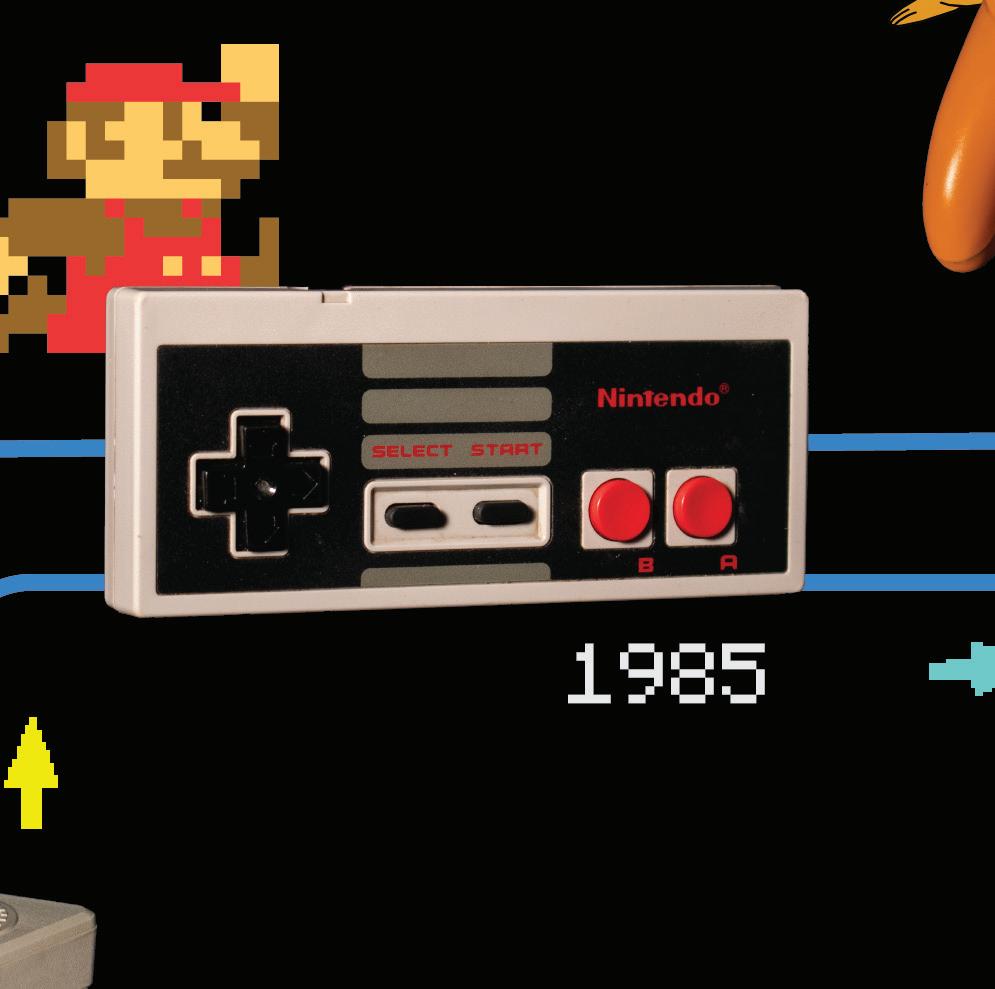
 Article by Fay Zhao
Graphic by Andrew Edwards
Article by Fay Zhao
Graphic by Andrew Edwards

Baby Boomers - Origins
In 1958, hundreds of excited people lined up in front of the Brookhaven National Laboratory to play the rst ever video game. Its exhibit held the star of the show, Tennis for Two. In the 65 years since, video games have evolved drastically across multiple generations, shaping the entertainment industry.




Tennis for Two displayed on an analog computer with two aluminum box-like controllers was created by American physicist William Higinbotham and was showcased in a three- day exhibition at a laboratory; the idea of a “video” game sparked many people’s interest. It portrayed a tennis match with two lines representing the court and the net as a player would hit the button that sent the ball over, and the other would try to receive it. is game set the stage for many more to come.
Despite video games existing in the late 1950’s, they were scarce. Most baby boomers grew up away from technological entertainment and spent most of their childhoods outdoors.
“We played outside, came home from school and rode our bikes and did outdoor type of stu ,” ne arts teacher Janine Papin said. “Nobody ever stayed in... there was no sitting around unless you were doing homework or engaged in a project.”
When not playing outside, she spent her time creating crafts, drawing, painting and making up her theater shows. Papin never played video games and rarely watched TV.
GenX - Beginnings
Arcades sprouted up and became a popular destination for children. Computer Space, made in 1971, was the rst commercial coin operated arcade game. e popularity of these games inspired other companies to start creating video games.
One game in particular, Space Invaders, created in 1978 by the Japanese company Taito, captured the players’ attention with record sales. e 2D shooter game trans xed the audience, as the more challenging the levels got, the harder it was to stop shooting the colorful aliens.
As well as arcade games, the rst at-home consoles were created in this generation. One of the rst was the Magnavox Odyssey created in 1972.

For once, people did not have to spend time riding their bikes to the arcade and dealing with lines at their favorite arcade machine, instead they could simply play the games at home for hours on end.
e most popular of them all was the Atari 2600 created in 1977. e variety of colors brought more life into the video games than the dull shades of previous consoles did.


Even with the improvements though, the graphic and diversity of the games were still very limited. ey were pretty elementary, and the thrills were a victory,” English teacher Steven Garnett said. “[ ey] were pretty minor compared to CGI and the interaction of gangs.”
With video games still considered rare at home and mostly located in arcades, the children of Gen X spent most of their time doing other things and only played video games rarely.

March 2O23 12 Focus
Millenials - Boom of video games
By the 80’s, video games became more and more popular, and companies were meeting the growing demand. With the Nintendo entertainment system, the Nintendo company dominated the industry with superior consoles that had better graphics, gameplay sound, and color. Nintendo created many famous games like Mario Brothers, Donkey Kong, Tetris and more. By 1989, Nintendo’s newest handheld game console, the Game Boy, became every child’s favorite Christmas gift.
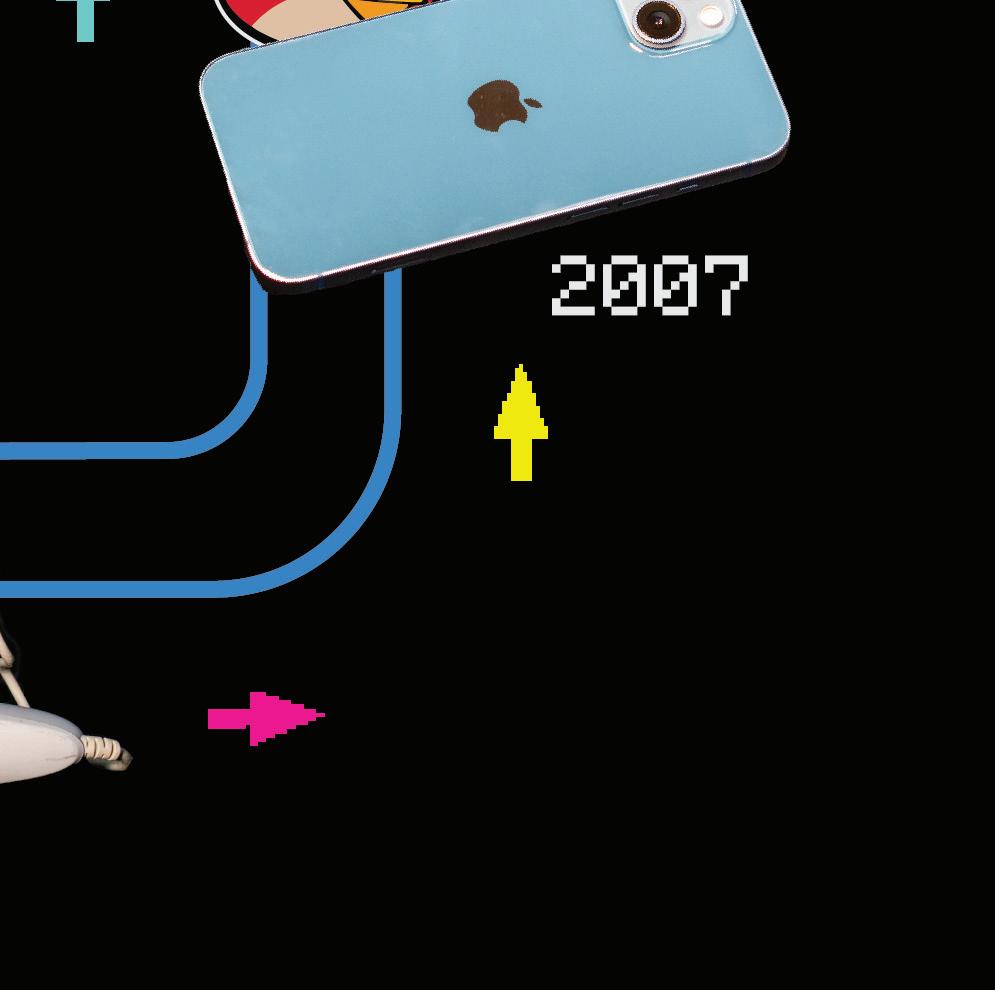


“When Game Boy rst came out, it was a big deal,” science teacher Bryan Moretz said. “I remember getting a Game Boy and playing things like Mario Brothers, and we have color.”


Competitions between companies to create better consoles and gaming experiences led to a diverse selection of games. Many include classics like Mario Kart, Sonic the Hedgehog and Pokemon. Sports games like John Madden and roleplay games like the Legend of Zelda were all created in this time period.




Gen Alpha - The Future
As technology advances, the industry is headed towards virtual reality. With big companies like Facebook promoting VR, the 3D display headset will likely be the next big thing in video gaming.

More than 214 million Americans play video games nowadays, far more than those who played Tennis for Two in 1958.

“It’s changed so much, the graphics are better,” Moretz said. “ ey’re much more expensive. they have a lot more di erent types of games. You know, I used to be limited to like a small section of selection of games. Nowadays, you have lots of di erent types of games, lots and lots of consoles.
GenZ - Modern Video Games
As the rise of video games continued upwards, big companies like Sony and Microsoft joined the competition with their own consoles of Playstation and Xbox. PlayStation 2, became the best console of all time, selling almost 158 million units in 2000.
As well as consoles at home, PC games became accessible and relevant. A simple click of a button led to a smoothly run game with high quality graphics. In addition, the variety of consoles and games on the PC contributed to the increased playing of video games.
“Now that we have more console options, and people are willing to spend more money, a lot more people are playing, we used to have just the consoles like our Nintendo or GameCube, PlayStation,” Moretz said. “But now we can play games on computers.”
By the late 2000’s, video games now exist in every corner of society, with games on PC, consoles, TV, along with motion sensor technology and mobile games.
Especially with the accessibility of video games, they are played frequently as they have become the norm and part of daily life with only a hand’s reach away.

“People do it in class if they’re bored,” Wermuth said. “It’s a lot of people’s hobby. It’s a lot of people’s way to relieve stress or to entertain themselves.”
As well as video games being a hobby source of entertainment, nowadays, playing video games can lead to something greater and potential opportunities.
“Nowadays there are Esports teams that people can play, there are tournaments, there are online competitions,” Moretz said. “Like when I was growing up, there was never even a thought that we would become like a game developer game designer, but nowadays that’s a very popular career choice that people move into.”

March 2O23 Focus 13
The celebrities who transformed each generation

Baby Boomers - Betty White

A little over one year ago, America was sent into mourning over the death of Betty White, who died just weeks short of her 100th birthday. e “Golden Girls” star and eight-time Emmy award winner shattered barriers and acted as a role model for not only baby boomers but all generations.
White was one of the rst women in Hollywood to work both on and o screen, allowing the women after her to follow in her footsteps. She is considered the rst woman to host a talk show (“Hollywood on Television”) and produce a sitcom (“Life with Elizabeth”). In her star role as Elizabeth, White continued to reform archaic stereotypes.
“White broadened the typical range and role of the ditzy housewife character with a winking self-awareness and proto-feminist irreverence,” explains Smithsonian National Museum of American History curator Ryan Lintelman in the Smithsonian Magazine’s article, “How Betty White Broke Barriers for Women in Television.”

Right up until her death White acted as a public servant, paving the way for female comedians and producers.

“As the ages continued, seeing Betty White mature and come into her own was really great,” computer science teacher Susan Frederick said. “She was acting right through into her 80s [and]... 90s.”
Gen X - Robert Downey Jr.
Gen X: hardworking, self-reliant, and self-destructive. Growing up, Gen Xers were very independent because of the heightened popularity of the dual-income family model. Gen X as a whole is notorious for questioning authority and the traditional values their baby boomer parents exempli ed. e middle child generation, forgotten in between the baby boomers and millennials, found their voice in the late 80s/early 90s as star Robert Downey Jr. began his rise to fame with movies like “Only You” and “ e Pick-Up Artist.”
A few years later, Downey began making headlines due to his substance abuse, drawing a parallel between him and the rest of Gen X. BBC News found that people born in the 60s and 70s (older GenX) have the highest likelihood of dying from suicide or drug abuse.

“It was a time when being self-destructive seemed in. And we weren’t quite sure what we were rebelling against… I remember when I was at my very lowest, my dad,...said, ‘Hey kid, stick around. It’s not so bad. Just stay on the planet,’” Robert Downey Jr. said in a speech at the Time 100 gala at Lincoln Center in 2008.

Shortly after his recovery, Downey debuted as Iron Man, making the ultimate comeback. 10 movies and 435 million dollars later, Downey solidi ed himself as a true superhero.


Similarly today, GenX can be seen making a comeback of their very own as 80s and 90s culture continues to make it big in coming years. From reboots of Fresh Prince of Bel-Air and Jurassic Park to the rising height of combat boots, it’s clear that from here on out, the “middle child” generation shall no longer be forgotten.

Focus
Article by Lucy Chong
Graphics by Austin Yuan
2O23
March
Millennials - Brittany Spears
In 1998 the world of pop was forever changed with the release of Britney Spears’ rst song, “...Baby One More Time,” which topped the Billboard charts for six weeks and sold over 1.8 million copies. e 17-year-old singer held onto her fame and starred in the childhoods of millennials everywhere.

“I vividly remember nding out when…Britney Spears [was] going to release a music video on MTV, and us rushing home to watch the release after school,” science teacher Anthony Palumbo said.
Spears permanently left her mark on pop with her good-girl-gone-bad narrative (inspired by Madonna), paving the way for other artists such as Lady Gaga, Katy Perry and more.
“Without Spears, Gaga and other current artists’ scandalous public personas would not be considered “unique” or a “force,” but rather would receive criticism,” writes Jess Garrigan in MK Pro les’ “Britney Spears: e Risqué Image that Changed Pop.”

Although Spears’ image is the norm in pop today, this was not the case during her early rise to fame, throughout which she faced heavy criticism for the way she dressed and presented herself. Yet, despite the controversy, Spears’ look played a huge role in turning her into the iconic pop star she is today.

In recent years, Spears has further solidi ed her role as the gurehead of the millennials as she has worked towards ending her conservatorship. From 2008 to 2021, Spears was under the conservatorship of her father, Jamie Spears, meaning that he had complete control over her life in terms of personal, legal and economic a airs. In protest, fans began #Free Brittany, an organized movement intended to bring Spears her freedom.
Born at the start of a new century and in a time of optimism, the millennials were dubbed the ‘happy-go-lucky’ generation early on in their lives. However, Spears’ journey represents a turning point for millennials.




“Our naive optimism is gone, once and for all. It has been replaced by a more mature version of the Millennial belief in a good world — the desire to have goodness win,” writes Berenike Schriewer, Ph.D. on Medium in “Britney Spears Is Becoming the Kurt Cobain / Greta of Millennials.”
GenZ - Zendaya
From Disney Channel’s “Shake it Up” to HBO’s “Euphoria,” Zendaya has grown up alongside GenZ for over a decade, making her one of the generation’s most prominent celebrities.

e biggest reason behind Zendaya’s success is the fact that she is simply hard to hate. roughout her career, Zendaya has consistently used her platform for good. She works as an ambassador of wwwwFriends for Change, has helped raise money to support the Convoy of Hope’s Women’s Empowerment Initiative, volunteered in Africa with UNAIDS and more.
Due to inheriting a laundry list of social issues, Gen Z has proven to be more politically active in creating change than any other previous generation. ese values often manifest in who GenZ chooses to promote, making it a no brainer as to why Zendaya is so popular.
“They [celebrities] spread [messages] because they know they have a following of people our age and younger,” sophomore Reese Tannis said. “ ey use their platform to spread good messages.”
March 2O23 Focus
GEN Z IS THE KEY Youth’s impact of continous acceptance and progressivism
Article by Carol Marques Graphic by Caden Liu
In today’s society, hints of progressiveness from Gen Z are seen all throughout. Through TV shows including characters dealing with mental health, toys that include different genders and races, social movements that advocate for new policies… Gen Z is much more obvious with its open-mindedness than generations before.
Gen Z, those born in 1996 - 2012, is known for its acceptance of all ethnicities, affiliations and especially mental health. This open-mindedness is one of the key features of this inclusive generation.

“Each generation is evolving as we as a society evolves,” registered mental health counselor Katherine Deery says. “Millennial beliefs trickled down to Gen Z, which made them even more seeing and feeling. Gen Z has really taken the torch and ran with it a lot farther than the generations before.”
In the past 15 years, this generation has faced several mass events like mass shootings, abortion laws, increasing danger of climate change, and COVID-19, that have led to an empathetic approach and open-mindedness.

“The world has gone through a lot since Gen Z has arrived on the scene, and that’s a lot to process at a young age,” Deery says. “I think that it is super anxiety-inducing and traumatic for a generation that has grown up with a lot of big events on the news.”
Unlike generations in the past, Gen Z has access to the world in real time, at the touch
of a button. Social media and the internet allow this generation to be more influenced than any generation before as Gen Zers were born during the rise of technology. According to school counselor Rylan Smith the large exposure this generation faces is something no other generation has had to deal with.
“I was definitely sheltered and there was a whole world out there that we didn’t really know about until we got older,” Smith said. “I think your world has always been huge, whereas my world was not very big until I left for college and even then it was, you know, somewhat limited.”
This enormous and accessible social media world tends to be linked to the negative sides of mental health, especially in teenagers. However, Deery argues that social media has been the main cause of Gen Z’s open-mindedness and willingness to speak about tough topics revolving around mental health.
“There’s definitely an innate desire for us as human beings to connect and to feel like we belong and when people share more about mental health it does create an atmosphere of connection and belongingness,” Deery says. “Exposure leads to more influence, which leads to more people reflecting and introspecting on their own experiences.”
Social media allows for youth to reach out and connect with others that might be experiencing the same situation. This connectivity can be beneficial when it comes to mental health and not feeling alone.
“The increased connectivity of youth, whether that be through social media, or just being able to pick up your phone and call someone, creates an open dialogue space where people feel safer to share their mental health needs,” junior Rhea Maniar said. “I think that we are more accepting of mental health as Gen Zers in general, because we are all educated on it.”
According to a report released by the American Psychiatric Association in 2019, Gen Z is more likely to receive treatment or have gone to therapy compared to other generations.



“I’ve seen students be much more willing to bring their friends by and their friends more willing to come by when they need help,” Smith said. “People are more willing to share that they see a therapist and just be more open to your peers.”
Social media and its effect on mental health is just one of the issues advocated by Gen Z. Diversity, equity and inclusion, a hot topic in today’s political and educational climate, is also at the forefront of what Gen Z hopes to see in the future.
“I think that we are getting to the point now, where diversity doesn’t necessarily have to be something that we’re always consistently and constantly thinking about,” Maniar said. “I hope that we get to a point where everyone can acknowledge the fact that diversity and inclusion is not something new and radical and progressive, rather it is something that is taught from an early age, like normal learning and practice.”
March 2O23 Focus
CHANGING TIMES, CHANGING TUNES
A journey through the evolving landscape of music
Article by Zach Kleiman Graphics by Lia Garibay and Caden Liu

Every generation is defined by its music. From classical to jazz, rock and roll to hip-hop, no generation is limited to a single style of music. With each generation’s many genres of music, even the most selective, narrow-minded listeners can find something that speaks to them.
Each era has left a distinct mark on the music industry, a testament to its constant evolution and cycles of change. From the Beatles in the ‘60s to today’s hits and beyond, music continues to provoke emotions and act as an outlet to express how people feel, while its sounds, instruments, trends and genres stay in a state of flux.
The Beatles. Elvis Presley. The Beach Boys. The arrival of some of the biggest names in music history came about from a time hailed as the golden age of music. After World War II, the baby boomer generation emerged, stimulating musical trends like the birth of rock and roll and the evolution of swing jazz.
“[The ‘50s and ‘60s] are the best. The music is upbeat and feelgood, and I think that’s what music needs to be,” math teacher Lynn Wilbur said.
Due to the rock and roll revolution, global interest in the music industry skyrocketed, eventually leading to the first annual Grammy Awards in ‘58. No longer playing in clubs and bars, musicians transformed into full-fledged superstars, performing to sold out stadiums and arenas, including festivals like Woodstock in ‘69.
The emergence of rock and roll in the ‘50s and ‘60s set the stage for a musical revolution in the coming generation, with groups like Metallica and Queen along with growing new genres such as punk rock and hip-hop.
In the ‘80s, hip-hop exploded, with artists like the Beastie Boys and Run DMC bringing their distinct sounds to the masses. This new music pushed the envelope further than any other genre before it, conveying strong messages of social justice and provocative lyrics.
Along with these new genres, the advent of new technologies such as the Walkman created mass popularity in the music industry, which sold over 400 million units by the time it was discontinued in 2010.


“[My dad] bought us the original Sony Walkman when it came out in ‘79,” history teacher William Milsten said. “And that blew me away, it was a game changer.”

Marking the peak of the boy-band era, musicians such as NSYNC and the Backstreet Boys took over the airwaves alongside teen pop superstars including Britney Spears and Christina Aguilera. The influence of hip-hop was still prevalent – only with new faces – as artists like Kanye West and Jay-Z began topping the charts.
As the Internet brought about a rise in music sharing, underground music such as EDM and underground hiphop soon caught the attention of a wider audience.
“Technology makes music better,” social science teacher Benjamin Gaddis said. “[It is] more collaborative than it ever was.”
Sites like iTunes, YouTube and Napster allowed for easier access to music, and with the rise of new ways to listen to tunes such as the MP3 player and the iPod, music’s popularity increased.

In today’s day and age, the Internet is a part of nearly everything we do. Due to this rapid digitization, unseen sounds and lyrics have become more prevalent, with artists such as Billie Eilish, Playboy Carti, and Harry Styles entering the mainstream.
Gen Z has unprecedented access to a variety of music platforms and genres, allowing them to easily discover and explore new music. According to a recent school-wide survey, 72% of respondents listen to pop, 54% listen to hip-hop/rap, and 41% listen to rock.
“I think music is the best right now in terms of diversity and range of listening,” junior Eva Chong said.
With this digital revolution underway, social media platforms including TikTok and YouTube began to gain a massive following catering towards younger generations, particularly Generation Alpha (born from 2013 onward).
March 2O23 Focus
Baby Boomers (‘46-’64)
Gen X (‘65-’80)
Millenials (‘81-’95)
Gen Z (‘96-’12)
Article by Karthik Stead Graphics by Andrew Edwards
From its humble radio beginnings to the cultural phenomenon it is now, the game show has become a staple within the cultural zeitgeist. Whether it’s “Who Wants to be a Millionaire,” “Jeopardy!,” “Family Feud” or “Wheel of Fortune,” these shows have brought joy to people all over the world. However, when you look at the time periods in which these shows first appeared, an interesting pattern begins to emerge, as the shows reflect the attitudes of the eras in which they originated.
Jeopardy!
Since it started airing on March 30, 1964, “Jeopardy!” has been nonstop. The show averaged 9.2 million total viewers across its 20212022 season, and the continued relevance of “Jeopardy!” is nothing short of incredible. The game involves contestants picking different questions of various difficulty. However, looking at the climate of the time it aired gives interesting insight as to what made this show resonate with viewers. In 1964, the U.S. was two years out of a recession, so a game show in which people simply had to answer trivia questions in order to gain desperately needed wealth resonated with many. According to Britannica the show has maintained ratings as one of the most popular shows in the country since its original airing.
Wheel of Fortune
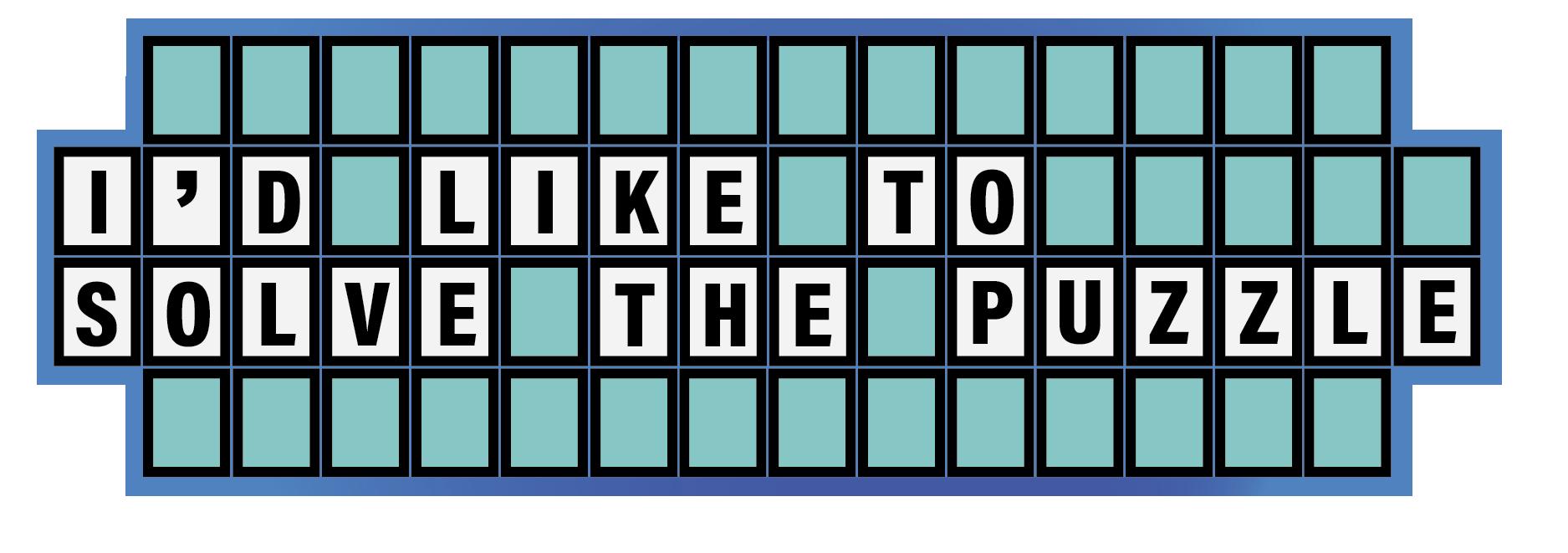
Coming from the same mind behind “Jeopardy!,” Merv Griffin, “Wheel of Fortune” has aired continuously from its original airdate on January 6, 1975. “Wheel of Fortune” in volves contestants both solving word puzzles, like many of the game shows at the time, while also spinning the titular wheel in order to see which prize they will earn. The 1970’s were a time of major change in the U.S. In 1972, Congress passed the Equal Rights Amendment, which reads: “Equality of rights under the law shall not be de
nied or abridged by the United States or by any state on account of sex.”. “Wheel of Fortune” remains one of the few game shows that features a man and woman co-hosting, with Pat Sajak and Vanna White currently having the mantle. This was always present in the show with Susan Stafford being the original hostess of the show. A show in which a man and a woman co-hosted seemingly acted as a response to the call for more female representation in male-dominated spaces, such as television. According to the New York Post, Vanna White has now filled in as the main host for Pat Sajak on multiple occasions.
Family Feud
“Family Feud” has gone through multiple revisions over its lifespan, changing hosts from Richard Dawson to Ray Combs and eventually to Steve Harvey, who hosts the show today. The show first aired on July 12, 1976 with Richard Dawson as the host. The 1970’s gave rise to a large conservative movement, largely in response to the popularity of the hippie movement the decade prior. According to Britannica, this movement focused on many issues, but the idea of “traditional” roles and the value of the family unit was vital to many Americans. The concept of a game show in which a family works together in order to answer questions and earn money to share together was born out of these ideas.
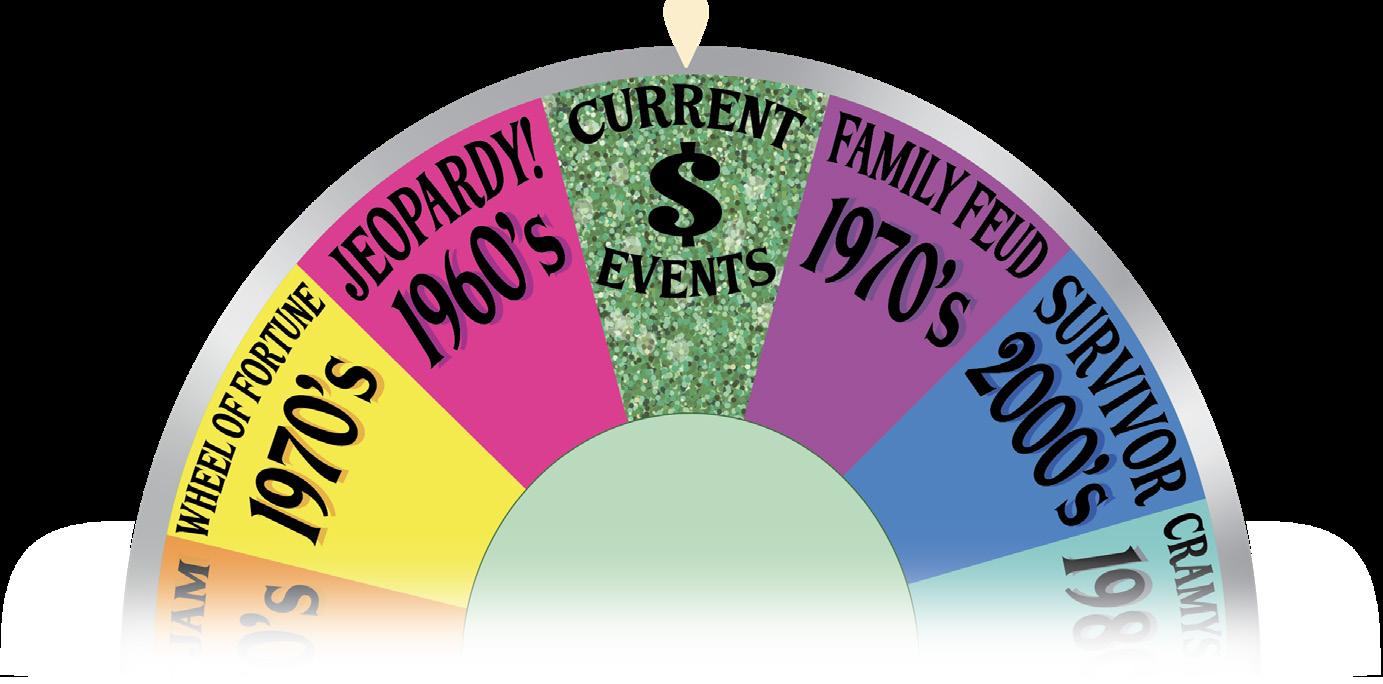

Modern Shows
The British smash hit “Who Wants to be a Millionaire” is one of the most popular
ing numerous spinoffs and being the driving element behind the 2008 film “Slumdog Millionaire.” The show first aired on September 4, 1998 and featured the contestant answering increasingly difficult questions with the goal of earning the titular $1 million cash prize. The show premiered eight years after the resignation of Prime Minister Margaret Thatcher, however the U.K. was still very much under the influence of her pro-capitalist policies. The idea that if one were to work hard enough they could join the ranks of the upper class was widely-held at the time.
Moving to the U.S., “Survivor” has become a household name since its premiere on May 31, 2000. The show involves the contestants living on an island and competing in various challenges in order to advance their “tribe.” The contestants must also choose who to vote off of the show, narrowing the pool of contestants each episode. Unlike its predecessors, the show features reality television elements, such as individual interviews with the contestants.
“Survivor” is also serialized, meaning the game takes place over an entire season. The show features team dynamics similar to “Family Feud,” but ultimately still encourages individuality because only one contestant can win the show. The show’s emphasis on reality television elements and strong senses of individuality was influenced by well-performing reality shows such as “Keeping up with the Kardashians.” Both shows feature elements of individualism consistent with the values of their coutnries at the time.
The Game Show has provided entertainment for generations, and has, too, reflected the generations in which they were created.
From the economic values of 1990’s Britain to the era of rapid change of the American 1970’s the game show has been ever-present, responding and adapting to the culture.
March 2O23 Focus 18
Game shows reflect the key values and ideas of their time







March 2O23 Advertisements
RACE AGAINST TIME
 Article by Amanda Rose DeStefano Graphic by Lia Garibay
Article by Amanda Rose DeStefano Graphic by Lia Garibay

Millions of customers flock to the skincare industry everyday, looking for a fix to erase wrinkles and sun damage alike. In recent years, anti-aging has become less taboo and more scientifically centered. Cutting edge technologies have swarmed the market with promises of staying young. The promises of aging gracefully bring with them a terrifying obsession with staying young. The anti-aging industry has brought with it a morbid fascination with beating the clock forever, and it’s gone too far.
It seems as though marketing teams are working overtime to make us aware of our flaws before we even notice them. Scrolling through social media, it’s easy to notice a new trend everyday which highlights natural traits showcased as something to get rid of. A particular sector of self-care efforts is in anti-aging.
Anti-aging has transformed from a pipe-dream to a multi-billion dollar industry. In 2021, this market reached $4.9 billion in the United States alone, a billion dollar increase from its worth in 2016. The anti-aging industry is no stranger to good marketing. As it continues to profit off of insecurities, we become permanent customers obsessed with the idea of staying younger for longer.
“It’s a very man-made thought process of how…when you show your age, it makes you look worn and tired,” sophomore Sarah Currie said.
New technology has shifted the market from purely surgical remedies to more preventative ones. Now, non-invasive techniques are capturing the attention of skincare junkies. These inventions range from sideways straws to avoid fine lines around your mouth to stickers that cover the width of your forehead to tighten your skin while you rest. The advertising surrounding aging has contributed strongly to the anti-aging epidemic.
As the market expanded, so did the pressure to keep up. Aging has been plastered on ads and packages as a disease in need of a cure. While anti-aging research grew, so did the world’s fear of looking older. The medical field responded with a laundry list of solutions, many of which backed by science.

One example of a scientific response is the introduction of botox to the market in 1989. Botox, made from botulinum toxin, is a treatment that paralyzes facial muscles to create the appearance of fewer wrinkles. While previously seen as taboo, it seems that the social standing on treatments such as botox has switched from shame to acceptance, with more than 4.4 million people getting the procedure in 2020.
The battle against aging hasn’t just stopped at minor procedures like these, though. Surgical dermatologist, Fayne Frey, explains that the oath she took to enter the medical professional world has become increasingly harder to fulfill with the progression of the skincare market.

March 2O23 Opinions
2O
Obsession with anti-aging is an unwinnable endeavor

“Do no harm” is a promise she made in 1987, but she reports to NBC News that keeping this promise is a challenge in her field. Doing no harm means avoiding financial, emotional and physical harm, but these are hard to meet as the humiliation of aging people always finds a home in offices like hers.

There is a fine line between reality and the expectations of anti-aging consumers. A specific moisturizer can alleviate skin conditions such as eczema, rosacea and acne, but a topical treatment has never conquered the erasure of a wrinkle.
The challenge also has some dangerous side-effects. Botox injections can cause bruising, pain, bleeding and headaches among other things. Chemical peels have been attributed with swelling, redness, scarring, infection, along with heart, kidney and liver damage. It’s clear how meeting your customers’ wants can easily do harm. Regardless of the consequences of such treatments, society has conditioned us to value a youthful appearance over anything else.
The happy-medium between looking younger and looking natural is easy to mess up too. People who do decide to go the surgical route sometimes find themselves being taken too far. We as on-lookers find ourselves asking the question, “you paid money to look like that?” while applying our prescribed retinol treatment to reduce fine lines. Shame narratives also exist internal to the anti-aging industry. Anti-aging is a movement driven by judgement and shame, inevitably resulting in disillusionment.

It is the obligation of members of society to deconstruct the humiliation of aging that exists within our lives. While plastic surgery and expensive facial serums might help individuals feel better about themselves, the movement is bigger than individuals. Deconstructing the culture of youth takes advocacy and time to speak out against treating aging as an illness instead of an accomplishment.
“I think aging is beautiful. It shows your life on your face,” Currie said “… aging is a natural progression of life.”

March 2O23 Opinions
21
PRO: HARDER CLASSES MAKE FOR BETTER FUTURES
Article by Sammy Lou Graphic by Caden Liu

At some point in all students’ lives, they have dreamed of becoming the best at what they love, whether it be the next great astronomer or the next great author. In a world of seemingly in nite career possibilities, never has it been harder to actually achieve a dream career. Nowadays, the race to get into college and climb the ladder of success is unbelievably competitive. According to a blog from Spark Admissions, Columbia University has a 5.1% acceptance rate today compared to a 32.3% acceptance rate in 1990.
One of the most e ective ways for a student to stand out is by having a rigorous schedule full of AP classes and other accelerated courses. Having this kind of schedule during middle school or ninth grade helps students not only stand out but also excel at their strengths and unlock their potential.
Unfortunately, most middle schoolers and ninth graders are not able to take many AP classes. According to a report from the College Board, only about 0.3% of AP students were middle schoolers and 9.1% of AP students were freshmen, 60% of which came from AP Human Geography. ese numbers are too low. Trinity should make more AP classes open to younger grades.
According to a 2019 College Admission Report, 80% of schools surveyed listed strength of curriculum as important for admissions.

Students who take AP courses signal to colleges that they are serious about their schoolwork and are willing to challenge themselves with tougher courses.
With increasing college admission demands, schools including Trinity are providing more opportunities for students to take advanced classes. Here at Trinity, ninth graders now are able to take multiple AP classes, as well as take math classes that are two or three years ahead of the average ninth grade curriculum. is is a start, but there still aren’t enough AP classes being o ered to freshmen. Also, pursuing a math-based career such as engineering requires an extensive amount of math knowledge beyond Calculus AB and BC.
Eighth grader Ashwin Anand is currently taking Honors Precalculus and dreams of eventually taking his passions to Massachusetts Institute of Technology (MIT).
“For most of my life, I’ve loved math, and that’s really what drove me to start taking more advanced courses,” Anand said. “ e school that I really want to get into is MIT, and that’s probably going to be really tough. But I feel that taking a lot of math courses and participating in math competitions will help a lot.”
Taking harder classes can also help students develop important life skills. According to the College Board, because of the demanding workload, AP students learn essential time management and study skills needed for col-



lege and career success. Even small advantages like this make a di erence in the eyes of college admission o cers and potential employers.
When a student is looking to develop their talents and challenge themselves, advanced courses can be used to their bene t. If the student is passionate about a certain subject, being in an advanced class can be a good challenge rather than being stressful. Freshman Joshua Whitney is passionate about computer science and is currently taking AP Computer Science. He enjoys the advanced class because he believes it challenges him more than a regular class would and allows him to further his knowledge on the topic.
“Probably around 20%-30% of my schoolwork time is devoted to my two AP classes,” Whitney said. “Not really more than another class.”
While taking an advanced course doesn’t automatically mean you become successful, it can help students’ chances in college and their careers and help them ful ll their passion. Right now, there are only a few AP classes that are open for ninth graders or middle schoolers, which is why more AP classes should be available to them.



Director of Learning and Instruction Stephanie Dryden is a strong advocate for students who are taking classes above the norm.
“It’s always exciting when a student pushes themself in math, journalism or music, and it’s a great thing to have those opportunities here,” Dryden said. “I think that’s a really
positive thing.”
March 2O23
Opinions
CON: PUTTING THE PRESSURE IN ADVANCED PLACEMENT
 Article by Jack Aaron Graphic by Caden Liu
Article by Jack Aaron Graphic by Caden Liu

When students see the phrase “Advanced Placement,” they often look past its di culty and what taking a class of that caliber means, and only see the status and grade point average bump that comes with the “AP” title. e reason for this mistake is because of the fact that college applications are becoming more and more competitive, and one of the ways to stand out among other applicants is by ahcieving high academic success. is has created a culture in which students feel pressured to taske these classes, just to feel even more pressure to succeed when they are taking the class.


Students are so focused on being in an honors or AP class that they lose sight of the fact that it might not be the best option for them. As a result, students may either drop down to a di erent level or su er with a bad grade.
“I feel that acceleration has harmed more than helped educationally,” Amy Tschudin, a mother interviewed by the Washington Post, said. “I would much rather have him gaining a solid foundation of knowledge and earning A’s and B’s than surviving with C’s and D’s in these push classes.”
Sometimes students enroll in advanced courses because of parental or peer pressure.
“You have kids who are in the top 3%, and those kids are usually ready… despite their age,” said math teacher Michael Hill, who teaches honors and standard
geometry. “It’s that next level of kids that just want to be with their friends, or their parents want to keep their kids where their other friends’ kids are.”
Even though it is entirely likely students can take classes that are above the normal for the grade and pass with ying colors, this is not the case for every student.
As an eighth grader, current freshman Owen Ra a took honors algebra II, a class usually taken by sophomores. Ra a said that the math itself was not too di cult, but he was not prepared for the workload, so he moved down to honors algebra I to return to honors algebra II the following year.
An article from journalist Christine Burke notes that the labor required for some classes, especially Advanced Placement, can be too much for students to bear. Burke uses her own son as an example to elaborate on this topic. She stated that her son stayed up four school nights a week until 11 at night to keep up with AP U.S. history alone. e amount of e ort her son had to put into his advanced class forced him to stop participating in social events with his friends, and even drove him to tears some nights.
Burke’s son does not go through this alone, as this pressure to take and succeed in AP classes is well-known by Trinity’s students.
In addition to the students who may not be ready to take a certain class, there will be those exceptional few students who may be able to succeed and take classes far beyond the norm for their grade level.
However, there will always be outliers. ere are students who are passionate about a particular subject and may reach exceptional success. Regardless, it is imperitive that all students feel comfortable with their classload and are able to acheive their own success. Course admission at Trinity must ensure that all students are placed into classes where they can succeed best.
So even if there are exceptional students who are ready to take on advanced and rigorous courses beyond the status quo, there is still the angle to ponder if they should take the course even if they are ready. Even if a student is ready to take a particular advanced course, there will be some sort of drawback. Whether it is losing downtime, or not having enough time outside of school to participate in extracurriculars, something will have to go when adding more accelerated courses. ough those examples do not go on your transcript, they do still hold signi cant value to students, and should not be completely forgone for the sake of advanced classes.
By increasing the grade requirement in entrance exams and establishing a higher grade average minimum to be referred to take Advanced Placement classes, students will be less stressed and may not have to drop down or live with a bad grade. In order to promote the general success of the TPS student communi-


to bad ty, this is the best course of action.

March 2O23 Opinions
SPEED AND SKILL Freshman Nathaneal Davis slides into the spotlight
Article by David Hull























































 Photo by Olivia Prince
Photo by Olivia Prince
Every great athlete has a moment in their career that sparks their passion. A split second when time stands still, creating a rushing feeling incomparable to anything else. For ninth grader Nathaneal Davis, it was when he hit his rst homerun.
“When I hit my rst home run, that was the day I got my con dence and drive to work hard and keep on playing the sport,” Davis said. “At that time it was hard and I thought about quitting, but as soon as I hit that ball, I was like ‘Yeah, I got this now.’”
Although Davis started playing baseball at a young age, he didn’t always have the dedication and drive he does today. Head varsity baseball coach Andrew Sutter started coaching Davis when he was 11 years old. According to Sutter, Davis had always shown exceptional athletic ability, but for the rst few years of his baseball career, he lacked the skill needed to compete at a high level.
“Nate was always a great athlete from the very beginning,” Sutter said. “But he was an okay or below average baseball player. Today, he’s become one of the top freshmen, not just in the state of Florida, but nationwide, and is being heavily recruited by a lot of Division I schools.”




Davis has become the ideal athlete for any coach, due to his unmatched speed, strength and dedication. He’s worked incredibly hard to become the
player he is today and is starting at center eld for Trinity during his freshman year. Davis already runs a sub 7-second 60-yard dash, making him one of the faster players in the area. Along with Davis’ elite speed, he is also a very skilled hitter.


and o the eld. Sutter believes Davis will be a great example for future student athletes to follow.
“I really think that he’s a perfect example of someone in the future that can help mentor young men and women that are coming in,” Sutter said.
difference
“I’m just the best at what I do,” Davis said. “I work harder than everybody, and I’m not cocky. I’m condent. ere’s a else.”
Davis previously played club baseball under Sutter for the Winter Park Diamond Dogs. When Sutter was given the head coaching position at Trinity this past o season, Davis wanted to play for him again. During his rst visit, Davis impressed everyone
he met.
“He has skill sets that are years ahead of his time,” Sutter said.
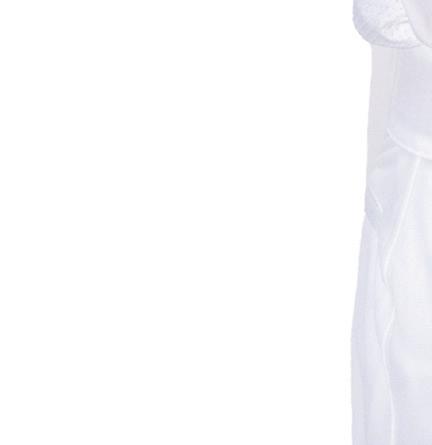

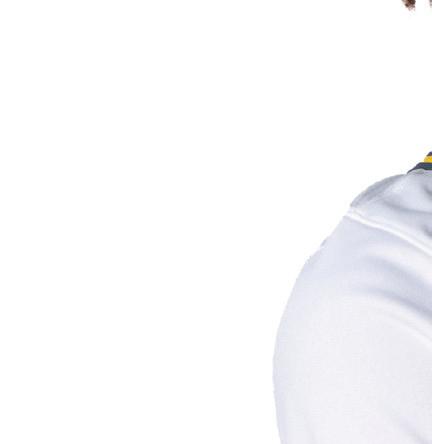

“Even our football coach here, Mike Kruzcek, said as soon as he saw Nate playing on the eld, that he’s the rst guy to ever have reminded him of
Deion Sanders.”


Sutter is confident in Davis’ chances to succeed at the next level
because he already possesses the skills of most collegiate athletes. Both Davis and Sutter are contacted weekly by coaches interested in the promising prospect. Sutter’s main involvement in the college process is to help Davis prepare for phone calls and visits with interested colleges.
Sutter said getting to the professional level requires something Davis can’t control: luck. Aware of the challenge of becoming pro, Davis is hoping that his skill can get him into a school that will provide him the best education possible.
“My main focus is to go to college and play ball,” Davis said. “I think I’ll play [well] in college, and my passion is still to play in the MLB, but even if I don’t, I’d still get that chance at a good education which is important to set me up to either start my own business or work for a good job.”
Whether it be in little league, college, or the pros, Davis’ passion for baseball has set him apart from the rest. Davis is grateful for the game, everything its taught him and the experiences its provided.
After transfer-

















After transferring from Avalone Middle, Davis has improved both on
“I love baseball,” Davis said. “It’s important to me for so many reasons. And I’ve learned a lot not just on the eld, but o the eld on how to take care of myself and to respect everyone no matter what [the] circumstance.”
March 2O23 Sports 24
between that because I know that I outwork everyone else.”
“I’m just the best at what I do. I work harder than everybody, and I’m not cocky. I’m confident. There’s a di erence between that because I know that I outwork everyone else.”
- Nathaneal Davis, Freshman
PERFORMING UNDER PRESSURE
Sophomore pitcher Aiden Stillman captures college radar
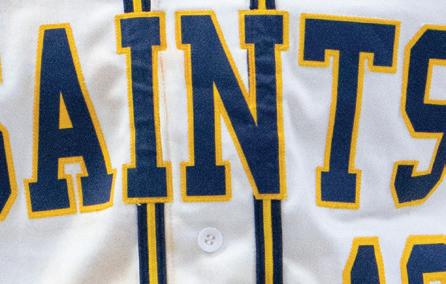

 Article by David Steinberg
Article by David Steinberg
 Photo by Olivia Prince
Photo by Olivia Prince
In baseball, the game often hinges on the pitcher—one slip up can change the outcome of a game. Under this pressure, most high school athletes would crumble, but not sophomore Aiden Stillman. For back-to-back seasons, Stillman has served as the starting pitcher for Trinity varsity baseball. Despite just being 16-years-old, Stillman has already gained interest from multiple high-pro le Division I schools across the country, something only few players can say.
Statistically, baseball is one of the most di cult sports to play at the collegiate level, with less than two percent of high school players nationwide going on to compete at the D1 level. At the pitcher position, college coaches look for size, strength and ability in prospects. Standing at 6’ 3” and 175 pounds with a strong left arm, Stillman has all of the physical attributes needed to play at the next level. Despite his age, Stillman can throw just under 90 mile per hour (mph), less than 8 mph o the average MLB fastball.
Despite Stillman’s physical gifts, what sets him apart from other top players is his competitiveness and drive. Stillman practices ve times a week for Trinity, followed by a lifting program each day and throwing practice on


Saturdays. While he doesn’t play club baseball during the school season, Stillman plays for the Winter Park Diamond Dogs each summer, one of the top teams in the area. Stillman’s passion for the game is what motivates him to continue playing and training at a high level.
“I really love the game, it feels weird when I’m not playing,” Stillman said. “I’m most comfortable on the baseball eld, it’s like my second home.”
Stillman began playing baseball at the age of 4 and immediately fell in love with the competitiveness of the game. From a young age, he has always enjoyed winning, but hated losing even more. Head Coach Andy Sutter began coaching Stillman at the age of 13 and has seen him take major strides on and o the eld. What impresses Sutter the most about Stillman’s game is the professionality and intensity with which he plays with.
“Aiden has always been a guy that will go out and leave everything on the eld,” Sutter said. “He is the most competitive guy I know on this team. He will ght to the end. He is a great teammate and will make sacri ces for anyone on
Along with being one of the most physically demanding positions in baseball, pitchers also face





























many mental challenges on the mound. e ability to bounce back after allowing a hit or walk requires maturity and a positive mindset, which players typically acquire as they grow older. Starting on varsity as a 15-year-old freshman, Stillman has worked on the mental part of the game just as much as the physical.
“I’ve always had the mentality of, ‘So what? Next pitch,” Stillman said. “ at’s what I’ve always been taught and what’s been hammered into my mind. Just because one thing happens doesn’t mean you can let it snowball into something bigger. Take a breath, regroup and move on.”
e way Stillman carries himself both on and o the eld is one of the reasons why he and the team have found recent success. Sutter admires Stillman’s character and drive, and believes he is a one-of-a-kind player who represents the best of Trinity.
“[Aiden] is someone that we as coaches look up to and have a lot of respect for,” Sutter said. “It’s an honor to coach him. He epitomizes the type of young man that you want to attend this school and to play sports here.”











































Stillman’s combination of hard work and determination has led him to become a top prospect in Central Florida. roughout freshman year, Stillman attended camps at the University of Virginia and Duke University, and has remained in close contact with the coaches at those colleges. As of recent, he has also started to talk to coaches at the University of Miami and the University of Central Florida.
From a young age, Stillman has always dreamed of playing at the Division I level. As he’s started to gain interest from coaches and schools, he nds himself one step closer to his goal. e college recruitment process has been a dream come true for Stillman, and he is excited to see what the future holds. Until then, he looks forward to competing for Trinity and continue doing what he enjoys.
“I love everything about baseball,” Stillman said. “Just the competitive nature to where I can control the game when I pitch, and that there’s no one to rush me. No one can tell me what to do. It’s up to me, and I get to determine how the rest of the game will look.”

March 2O23 Sports 25
ght to the teamthe team.”
FRESHMAN SERVES A LARGER ROLE
Benjamin Demetriades swings into the season with new goals and expectations
Article by Boaz Kim
 Photo by Raheel Patel
Photo by Raheel Patel
In tennis, line one is usually played by one of the most experienced and skilled players, typically a senior player. However, for the boys varsity tennis team, that is freshman Benjamin Demetriades. Demetriades might be a young player, but to him, tennis is nothing new because he has been playing for about ten years.
Growing up, his parents enjoyed playing tennis and initially introduced him to the sport. Demetriades said that the individual aspect of tennis is what really appealed to him.
“You’re out there on your own and it feels like you’re doing all the work and no matter the outcome, it is always going to be on you, so you can never really hold other people accountable besides yourself,” Demetriades said.
New boys varsity tennis head coach Martin Harach has only been coaching Demetriades for a little over a month and already has very high praise and expectations for Demetriades and the whole team.
“He’s got a lot of potential,” Harach said. “I mean you can see he has been taught very well, he is very neat, has athleticism and he is a smart kid. So, he has all the assets that a coach looks for to build into a great player. He is still young, being a freshman playing line one for us this year which is huge, can be good for his experience and whatever goals he has.”
Teammates of Demetriades such as senior Dylan Kling have high praise for Demetriades’ enthusiasm and work ethic.
“Ben comes into practice always excited and knows what he needs to work on for his next match,” Kling said. “He is overall a positive person to be around as a person and as a team-
mate he stays committed.”
Looking towards the future, Demetriades said that his goal and plan is to play for a collegiate level tennis team. Demetriades said some

sion II school. Harach then went on to coach at Auburn University in Montgomery and won a national championship with the girls team, while the boys were ranked top ve in the nation.
“My goal is to teach him [Demetriades] to mainly handle pressure,” Harach said. “We practice the same pattern over and over again because tennis is really mostly about handling pressure. It’s not necessarily about who has the prettiest forehand or the hardest serve, it’s about how you can keep the ball on the court and hold your composure when it’s time to win.”
Coming into this season, Demetriades has clearly stepped into a larger role since last year when he played on line three. Demetriades is embracing his larger role and has set some high expectations for himself this year.
of his dream schools include Northwestern University and Wake Forest University.
Harach is someone who can help players, like Demetriades, reach their goals as he is coming into the boys varsity tennis program with a lot of experience behind him. Harach grew up in Argentina, and as a junior he was ranked a top 50 player in the country. Harach later played at Young Harris College, a Divi-
“I want to win the district tournament, which will guarantee me an advancement spot in the state singles nals,” Demetriades said. “Also, I want the team to possibly make it to the nals as we did last year. Demetriades knows that he will have to put in the work in order to improve and reach his personal goals for the season, which is why he is always striving to be a better player.
“I make sure that I try to play people who are as good as me or even better than me because I think that you can’t improve when you are playing with people worse than you, and that is a mindset I try to carry with me at all times,” Demetriades said.

March 2O23 Sports 26
Freshman Ben Demetriades works on his forehand at a practice. Demetriades also trains outside of school by himself and with coaches. Demetriades is 8-0 so far this season.
BOYS SOCCER TEAM PASSES THE COMPETITION
Article by Alec Diaz
Photos by Olivia Kortman
On Feb. 23, the boys varsity soccer team won in a penalty kick shootout by a score of 5 to 3 against Nova Southeastern University High School. The Universtiy of Central Florida soccer commit and team captain senior Shane Wright made numerous saves to win the state finals for the first time in school history after having a regular season record of 8-2-1.
The team has a history of playoff success under head coach Ray Sandridge, who has been coaching at Trinity since 2019 and coaching in general for more than 40 years. Under Sandridge, the team has three regional finals appearances over the course of four years, along with this year’s state win.

Sandridge credits the success to their team chemistry.
“It sounds like it’s something that’s easy to do, but as the coach, I can’t do anything about that. I can’t make players, but this team has gotten along so well and it makes a difference,” Sandridge said.
The College of Charleston soccer commit and team captain senior Ryan Avallone said the key to the team’s playoff success has been the focus and drive to do better every game.

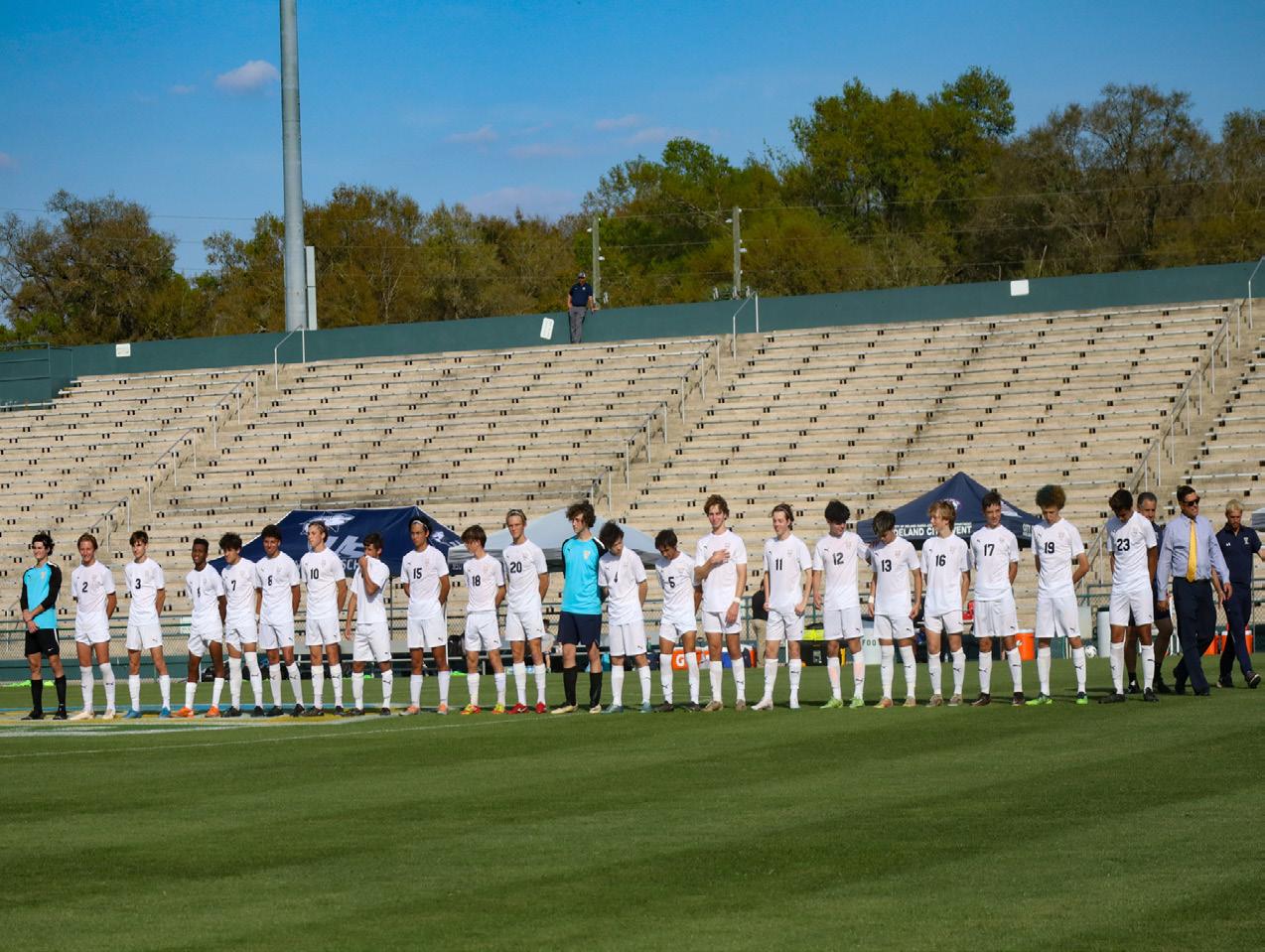
Senior Koray Tekin, who is a Vassar College soccer commit and also a team captain, said that Sandridge brings a “win-or-win mentality” to the team.
“I’m a pretty tough guy, I’d be honest with you, and we joke around a lot, but I’m one of these guys that demands perfection, but accepts excellence,” Sandridge said. “So that’s kind of where we start but obviously... they work extremely hard.”
Sandridge also credits their postseason success to the team’s aggressive defense, as well as the supportive fans.
“It means a lot for the boys that are playing, their parents come out there and they cheer for them,” Sandridge said.
Avallone said that the win still hasn’t been processed through his head yet, but that he is grateful for the season as a whole.
“Of course there was ups and downs and all our coaches were definitely holding us to a high standard as we’re the players being hard on each other but that is what resulted in us coming out on top and we are so thankful for Coach Ray, Lou, and Ryan!” Avallone said.
March 2O23 Sports 27
The boys varsity soccer team on Feb. 23 in Deland, where they beat Nova Southeastern University High School in a penalty shootout with a score of 5 to 3.
Brown dribbles the ball toward the goal in the second half of the FHSAA championship game. Brown committed to play soccer for St. Lawrence University in upstate New York.
PHOTOGRAPHY EXPOSITION Spring Sports Showcase

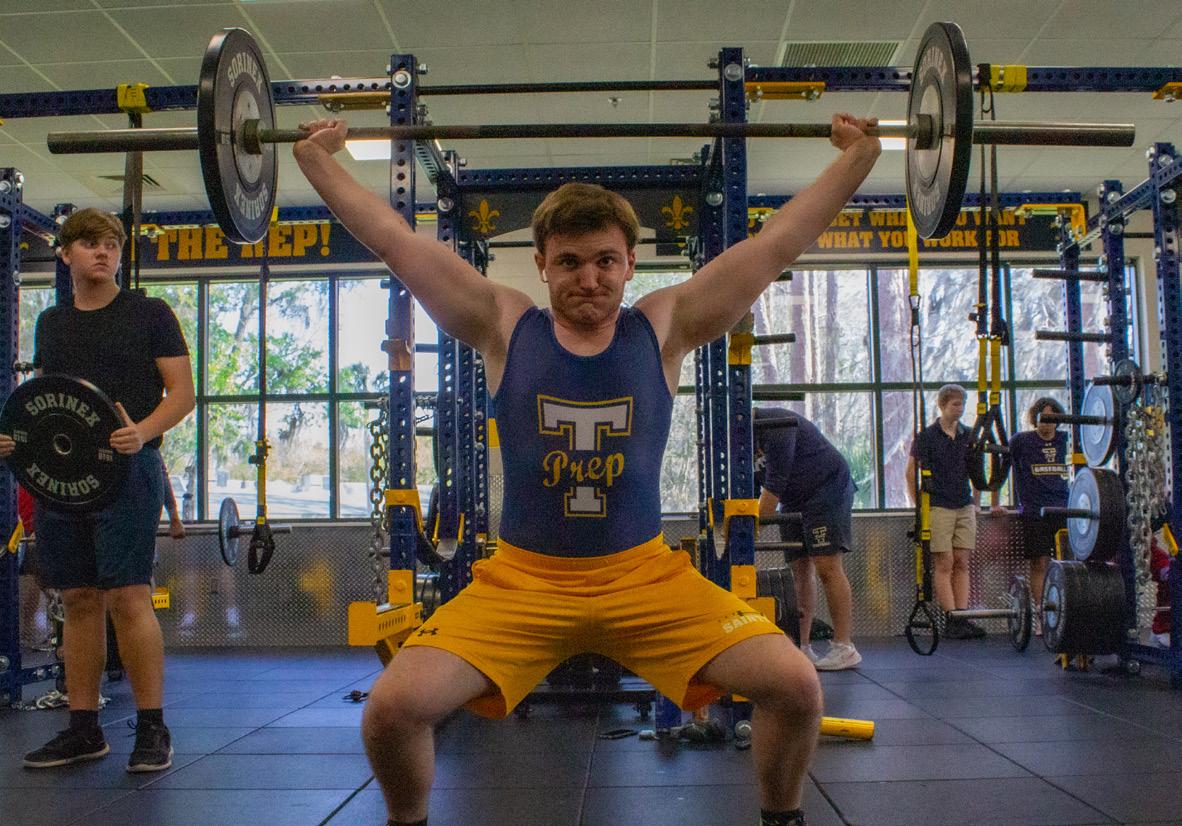




March 2O23 Photos 28
Andrew Edwards Junior Lucas Qu jumps into the air during a singles match to strike the ball back to his opponent. The boys team had a 7-0 win against Oviedo High School on February 13.
Raheel Patel
Olivia Prince Senior baseball catcher Brandon Garcia gets ready as his teammate is about to pitch. The Saints won 3-1 against Lake Highland on Feburary 24.
Anna Miliotes Sophomore Cara Mortimer runs the 800-meter race at the Lake Mary Invitational on March 4. Mortimer placed 20th in the race, and the Trinity girls team placed 5th overall.
Senior Anthony Miceli warms up his snatch before the recent virtual weightlifting meet on March 1. Miceli also recently hit a personal record during the meet for snatch at 170 pounds.




























































 Florida Governor Ron Desantis on College Board and the possible banning of AP Classes in the state of Florida.
breaks all time Grammy win record
chills in New Hampshire reach lowest recorded temperature
Brady retires after 23 seasons in the NFL
Chinese spy balloon and other mystery objects shot down by U.S. military
Multiple high magnitude earthquakes leave thousands dead and others injured in Syria and Turkey
Kansas City Chiefs win their second Super Bowl in four years with Patrick Mahomes taking home his second SB MVP
Boston Celtics’ Jayson Tatum wins the NBA All Star Game MVP with a record breaking 55 points
Florida Governor Ron Desantis on College Board and the possible banning of AP Classes in the state of Florida.
breaks all time Grammy win record
chills in New Hampshire reach lowest recorded temperature
Brady retires after 23 seasons in the NFL
Chinese spy balloon and other mystery objects shot down by U.S. military
Multiple high magnitude earthquakes leave thousands dead and others injured in Syria and Turkey
Kansas City Chiefs win their second Super Bowl in four years with Patrick Mahomes taking home his second SB MVP
Boston Celtics’ Jayson Tatum wins the NBA All Star Game MVP with a record breaking 55 points


































































 Article by Fay Zhao
Graphic by Andrew Edwards
Article by Fay Zhao
Graphic by Andrew Edwards
















































 Article by Amanda Rose DeStefano Graphic by Lia Garibay
Article by Amanda Rose DeStefano Graphic by Lia Garibay









































































 Photo by Olivia Prince
Photo by Olivia Prince

















 Article by David Steinberg
Article by David Steinberg
 Photo by Olivia Prince
Photo by Olivia Prince





































































